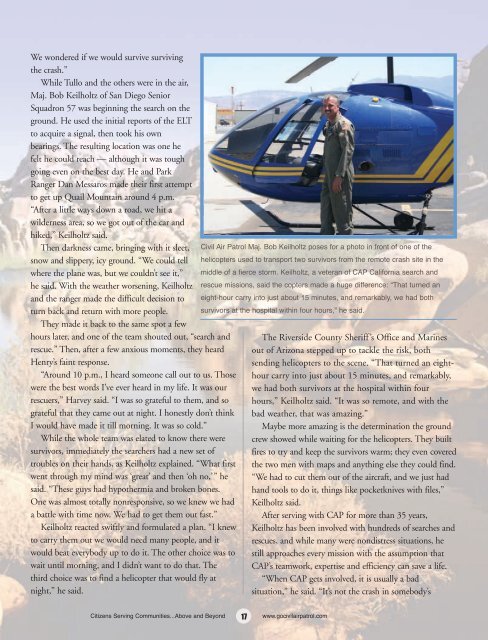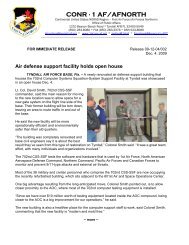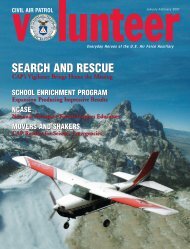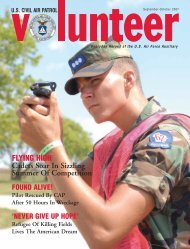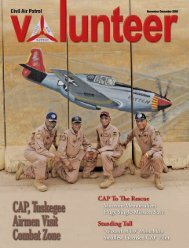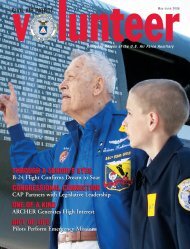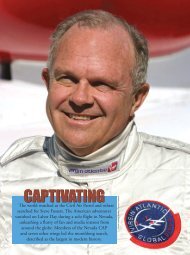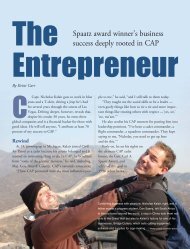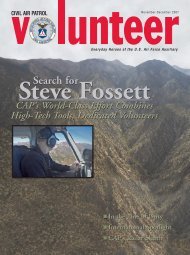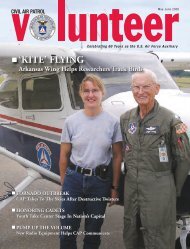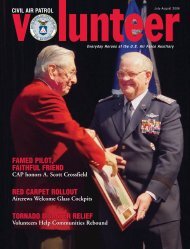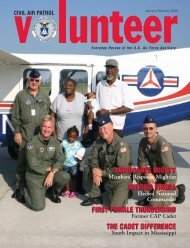You also want an ePaper? Increase the reach of your titles
YUMPU automatically turns print PDFs into web optimized ePapers that Google loves.
We wondered if we would survive surviving<br />
the crash.”<br />
While Tullo and the others were in the air,<br />
Maj. Bob Keilholtz of San Diego Senior<br />
Squadron 57 was beginning the search on the<br />
ground. He used the initial reports of the ELT<br />
to acquire a signal, then took his own<br />
bearings. The resulting location was one he<br />
felt he could reach — although it was tough<br />
going even on the best day. He and Park<br />
Ranger Dan Messaros made their first attempt<br />
to get up Quail Mountain around 4 p.m.<br />
“After a little ways down a road, we hit a<br />
wilderness area, so we got out of the car and<br />
hiked,” Keilholtz said.<br />
Then darkness came, bringing with it sleet,<br />
snow and slippery, icy ground. “We could tell<br />
where the plane was, but we couldn’t see it,”<br />
he said. With the weather worsening, Keilholtz<br />
and the ranger made the difficult decision to<br />
turn back and return with more people.<br />
They made it back to the same spot a few<br />
hours later, and one of the team shouted out, “search and<br />
rescue.” Then, after a few anxious moments, they heard<br />
Henry’s faint response.<br />
“Around 10 p.m., I heard someone call out to us. Those<br />
were the best words I’ve ever heard in my life. It was our<br />
rescuers,” Harvey said. “I was so grateful to them, and so<br />
grateful that they came out at night. I honestly don’t think<br />
I would have made it till morning. It was so cold.”<br />
While the whole team was elated to know there were<br />
survivors, immediately the searchers had a new set of<br />
troubles on their hands, as Keilholtz explained. “What first<br />
went through my mind was ‘great’ and then ‘oh no,’” he<br />
said. “These guys had hypothermia and broken bones.<br />
One was almost totally nonresponsive, so we knew we had<br />
a battle with time now. We had to get them out fast.”<br />
Keilholtz reacted swiftly and formulated a plan. “I knew<br />
to carry them out we would need many people, and it<br />
would beat everybody up to do it. The other choice was to<br />
wait until morning, and I didn’t want to do that. The<br />
third choice was to find a helicopter that would fly at<br />
night,” he said.<br />
Civil Air Patrol Maj. Bob Keilholtz poses for a photo in front of one of the<br />
helicopters used to transport two survivors from the remote crash site in the<br />
middle of a fierce storm. Keilholtz, a veteran of CAP California search and<br />
rescue missions, said the copters made a huge difference: “That turned an<br />
eight-hour carry into just about 15 minutes, and remarkably, we had both<br />
survivors at the hospital within four hours,” he said.<br />
The Riverside County Sheriff’s Office and Marines<br />
out of Arizona stepped up to tackle the risk, both<br />
sending helicopters to the scene. “That turned an eighthour<br />
carry into just about 15 minutes, and remarkably,<br />
we had both survivors at the hospital within four<br />
hours,” Keilholtz said. “It was so remote, and with the<br />
bad weather, that was amazing.”<br />
Maybe more amazing is the determination the ground<br />
crew showed while waiting for the helicopters. They built<br />
fires to try and keep the survivors warm; they even covered<br />
the two men with maps and anything else they could find.<br />
“We had to cut them out of the aircraft, and we just had<br />
hand tools to do it, things like pocketknives with files,”<br />
Keilholtz said.<br />
After serving with CAP for more than 35 years,<br />
Keilholtz has been involved with hundreds of searches and<br />
rescues, and while many were nondistress situations, he<br />
still approaches every mission with the assumption that<br />
CAP’s teamwork, expertise and efficiency can save a life.<br />
“When CAP gets involved, it is usually a bad<br />
situation,” he said. “It’s not the crash in somebody’s<br />
Citizens Serving Communities...Above and Beyond<br />
17<br />
www.gocivilairpatrol.com


